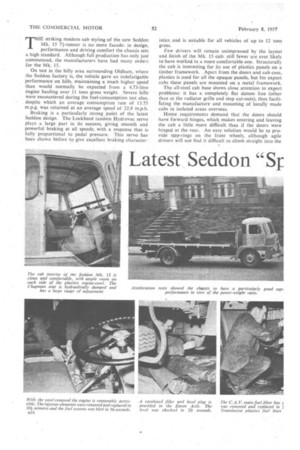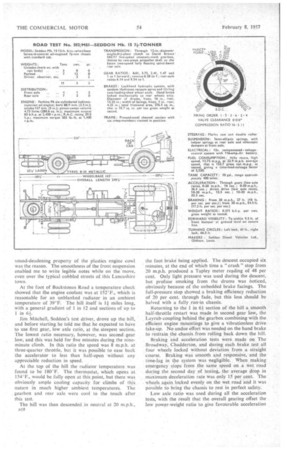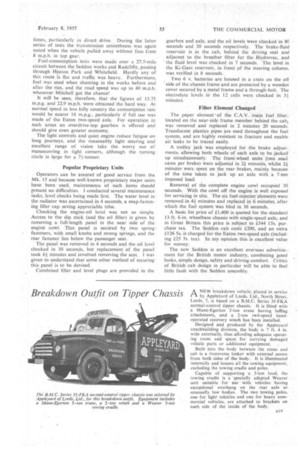Latest Seddon "Sr
Page 50

Page 51

Page 52

Page 53

If you've noticed an error in this article please click here to report it so we can fix it.
the Driver
THE striking modern cab styling of the new Seddon Mk. 15 7k-tanner is no mere facade: in design, performance and driving comfort the chassis sets a high standard. Although full production has only just commenced, the manufacturers have had many orders for the Mk. 15.
On test in the hilly area surrounding Oldham, where the Seddon factory is, the vehicle gave an indefatigable performance on hills, maintaining a much higher speed than would normally be expected from a 4.73-litre engine hauling over 11 tons gross weight. Severe hills were encountered during the fuel-Consumption test also, despite which an average consumption rate of 13.75 m.p.g. was returned at an average speed of 22.9 m.p.h.
Braking is a particularly strong point of the latest Seddon design. The Lockheed tandem Hydrovac servo plays a large part in its success, giving smooth and powerful braking• at all speeds, with a response that is fully proportional to pedal pressure. This servo has been shown before to give excellentbraking character istics and is suitable for all vehicles of up to 12 tons gross.
Few drivers will remain unimpressed by the layout and finish of the Mk. 15 cab: still fewer are ever likely to have worked in a more comfortable one. Structurally the cab is interesting for its use of plastics panels on a timber framework. Apart from the doors and cab case, plastics is used for all the opaque panels, but for export cabs these panels are mounted on a metal framework.
The all-steel cab base shows close attention to export problems: it has a completely flat datum line (other than at the radiator grille and step cut-outs), thus facilitating the manufacture and mounting of locally made cabs in isolated areas overseas.
Home requirements demand that the doors should have forward hinges, which makes entering and leaving the cab a little more difficult than if the doors were hinged at the rear. An easy solution would be to provide step-rings on the front wheels, although agile drivers will not find it difficult to climb straight into the cab in one step, the door sill being low as a result of its location ahead of the wheels.
A full-width design has been adopted for the cab, and because of the small plastics engine cowl there is generous room on the driver's side, with a genuine two-man seat on the near side. The steering column is shrouded by a plastics cowl, which is flared at the top to house the instruments and switches. This cowl is easy to keep clean and contains no oil and dust traps. " Luxury " appointments include ash-trays and plenty of polished woodwork.
There is a useful shelf for books, papers and personal oddments running the width of the. cab above the wide two-piece curved windscreen, but no other storage spade is provided. Excellent all-round visibility. is given by this design, although it is strange to find only one rearview mirror and windscreen wiper provided as standard. Similarly, an interior lamp is classed as an "optional extra."
Mechanically the Mk. 15 is similar to the Mk. 5 10-ton-gross chassis. A Perkins P6 83 b.h.p. six cylindered indirect-injection oil engine is used in conjunction with a David Brown 542/17 five-speed constantmesh gearbox. The engine-gearbox unit is mounted on rubber at four points, with Metalastik sandwiches in compression and shear at the front and Metacone fittings at the bell housing. The gearbox carries a forward-control extension for the gear lever, this being on the chassis .centre line.
• The chassis frame is straightforward, with six crossmembers. The vehicle tested had a bolted frame, but future production models are to have all-riveted frames. The Mk. 15 is offered with four wheelbases-13 ft. 6 in. (as tested) and 12 ft. 6 in. for normal haulage; 9 ft. for tippers and 7 ft. 6 in. for tractors. The tractive unit is rated for 15 tons gross .train weight, whilst the three rigid models have an 11-ton gross rating.
A spiral-bevel rear axle with a 6.66 to I reduction ratio is standard on all models except the prime mover, but an Eaton 16,500 two-speed axle is an optional extra and is standard equipment on the tractor. Helper leaves are used in the rear suspension and telescopic dampers assist the front springs.
The test chassis had a two-speed axle and standard cab, unpainted being straight Off the assembly line. Michelin B20 Metallic tyres were fitted, instead of the standard 8.25-20-in. (12-ply) equipment. The 6.00T rims can carry 9.00-20-in. (12-ply) tyres if specified. A 17-ft. 4-in.-platform test body had been provided instead of the 18-ft. 4-in, body permissible.
Kerb weight, complete with spare wheel and full fuel tank, was 3 tons 8 cwt. This is 17 cwt. above the weight of the stripped chassis, less cab and lubricants. Test weights totalling 7 tons 12 cwt. were added to bring the gross weight to the recommended figure.
For the first test the lorry was driven to Buckstones Road, Shaw, for engine-power and brake-fade tests. During the run out to Shaw I shared the passenger seat with a staff photographer, despite which there was plenty of room on our side of the engine for ourselves and bulky photographic and test equipment.
Engine noise in the cab was pleasingly restrained, contrary to the habit of indirect-injection engines of this size of making themselves heard; undoubtedly the n17 sound-deadening property of the plastics engine cowl was the reason. The smoothness of the front suspension enabled me to write legible notes while on the 'move, even over the typical cobbled streets of this Lancashire town.
At the foot of Buckstones Road a temperature check showed that the engine cdolant was at 152°F., which is reasonable for an unblanked radiator in an ambient temperature of 39°F. The hill itself is 1:1 miles long, with a general gradient of 1 in 12 and sections of up to 1 in 6+.
Jim Mitchell, Seddon's test driver, drove up the hill, and before starting he told me that he expected to hive to use first gear, low axle ratio, at the steepest section. The lowest ratio necessary, however, was second gear low, and this was held for five minutes during the nineminute climb. In this ratio the speed was 8 m.p.h. at three-quarter throttle, but it was possible to ease back the accelerator to less than half-open without any appreciable reduction in speed. •
At the top of the hill the radiator temperature was found to be 180°F. The thermostat, which opens at. 154°F., would be fully open at this point, but there was obviously ample cooling capacity for climbs of this nature in much higher ambient temperatures. The gearbox and rear axle were cool to the touch after this test. the foot brake being applied. The descent occupied six minutes, at the end of which time a " crash ". stop from 20 m.p.h. produced a Tapley meter reading of 48 per cent. Only light pressure was used during the descent, but profuse smoking from the drums was noticed, obviously because of the unbedded brake facings. The full-pressure stop showed a braking efficiency reduction of 20 per cent. through fade, but this loss should be halved with a fully run-in chassis.
Returning to the 1 in 61 section of the hill a.smooth half-throttle restart was made in second gear low, the Layrub coupling behind the gearbox combining with the efficient engine mountings to give a vihrationless drive take-up. No undue effort was needed on the hand brake to restrain the chassis from rolling back down the hill.
Braking and acceleration tests were made on The Broadway, Chadderton, and during each brake test all four wheels locked without deviation from a straight course. Braking was smooth and responsive, and the time-lag in the system was negligible. When making emergency stops from the same speed on a wet road during the second day of testing, the average drop in maximum deceleration rate was only 15 per cent. The wheels again locked evenly on the wet road and it was possible to bring the chassis to rest in perfect safety.
Low axle ratio was used during all the acceleration tests, with the result that the overall gearing offset the low power-weight ratio to give favourable acceleration times, particularly in direct drive. During the latter series of tests the transmission smoothness was again noted when the vehicle pulled away without fuss from 8 m.p.h. in top gear.
Fuel-consumption tests were made over a 27.5-mile circuit between the Seddon works and Radcliffe, passing through Heaton Park and Whitened. Hardly any of this route iS flat and traffic was heavy. Furthermore, fuel was used when shunting in the works before and after the run, and the road speed was up to 40 m.p.h. whenever Mitchell got the chance!
It will be seen, therefore, that the figures of 13.75 m.p.g. and 22.9 m.p.h were obtained the hard way. At normal speed in less hilly country the consumption rate would be nearer 16 m.p.g., particularly if full use was made of the Eaton two-speed axle. For operation in such areas an overdrive-top gearbox is offered and should give even greater economy.
The light controls and quiet engine reduce fatigue on long journeys, and the reasonably light steering and excellent range of vision take the worry out of manoeuvring in tight corners, although the turning circle is large for a 74-tonner.
Popular Proprietary Units Operators can be assured of good service from the Mk. 15 and because well-known proprietary major units haste been used, maintenance of such items should present no difficulties. I conducted several maintenance tasks, level checks being made first. The water level in the radiator was ascertained in 4 seconds, a snap-fastening filler cap saving appreciable tune.
Checking the engine-oil level was not so simple. Access to the dip stick (and the oil filler) is given by removing a full-length panel in the near side of the engine cowl. This panel is secured by two spring fasteners, with small knobs and strong springs, and the rear fastener lies below the passenger seat.
The panel was removed in 4 seconds and the oil level checked in 30 seconds, but replacement of the panel took 64minutes and involved removing the seat. I was given to understand that some other method of securing this panel is to be devised.
Combined filler and level plugs are provided in the gearbox and axle, and the oil levels were checked in 80 seconds and 30 seconds respectively. The brake-fluid reservoir is in the cab, behind the driving seat and adjacent to the breather filter for the Hydrovac, and ' the fluid level was checked in 7 seconds. The level in the Ki-Gass reservoir, in front of the steering column. was verified in 8 seconds.
Two 6 v. batteries are housed in a crate on the off side of the chassis frame and are protected by a wooden cover secured by a metal frame and a through-bolt. The electrolyte levels in the 12 cells were checked in 3; minutes.
Filter Element Changed The paper element -of the C.A.V. main fuel filter, located on the near-side frame member behind the cab, was removed and replaced in 2 minutes 20 seconds. Translucent plastics pipes are used throughout the fuel system, and are highly resistant to fracture and enable air leaks to be traced easily.
A trolley jack was employed for the brake adjustments, allowing both wheels of each axle to be jacked up simultaneously. The front-wheel units (two snail cams per brake) were adjusted in 2+ minutes, whilst 21 minutes were spent on the rear brakes, mainly because of the time taken to jack up an axle with a 7-ton imposed load.
Removal of the complete engine cowl occupied 30 seconds. With the cowl off the engine is well exposed for servicing in situ. The six fuel-injector elements were removed in 4+ minutes and replaced in 6 minutes, after which the fuel system was bled in 36 seconds.
A basic list price of £1,400 is quoted for the standard 13-ft. 6-in, wheelbase chassis with single-speed axle, and in Great Britain this price is subject to £344 15s. purchase tax. The Seddon cab costs £200, and an extra £126 5s. is charged for the Eaton two-speed axle (including £25 5s. tax). In my opinion this is excellent value for money.
The new Seddon is an excellent overseas advertisement for the British motor industry, combining good looks, simple design, safety and driving comfort. Critics of British cab design in particular will be able to find little fault with the Seddon assembly.




































































































